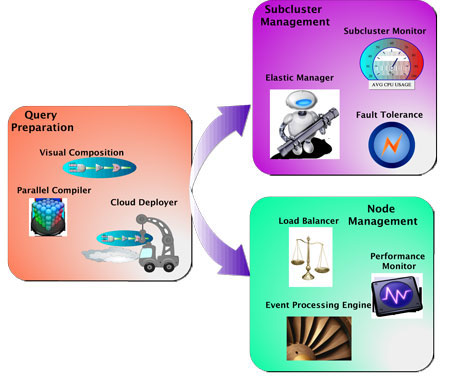by Vincenzo Gulisano, Ricardo Jimenez-Peris, Marta Patiño-Martinez, Claudio Soriente and Patrick Valduriez
To date, big data applications have focused on the store-and-process paradigm. In this paper we describe an initiative to deal with big data applications for continuous streams of events.
In many emerging applications, the volume of data being streamed is so large that the traditional ‘store-then-process’ paradigm is either not suitable or too inefficient. Moreover, soft-real time requirements might severely limit the engineering solutions. Many scenarios fit this description. In network security for cloud data centres, for instance, very high volumes of IP packets and events from sensors at firewalls, network switches and routers and servers need to be analyzed and should detect attacks in minimal time, in order to limit the effect of the malicious activity over the IT infrastructure. Similarly, in the fraud department of a credit card company, payment requests should be processed online and need to be processed as quickly as possible in order to provide meaningful results in real-time. An ideal system would detect fraud during the authorization process that lasts hundreds of milliseconds and deny the payment authorization, minimizing the damage to the user and the credit card company.
In this context, researchers have proposed a new computing paradigm called Complex Event Processing. A complex event processor (CEP) is a system designed to process continuous streams of data in near real-time. Data flows in streams that are not stored, but are rather processed on-the-fly. Similar to database management systems (DBMS), a CEP processes queries over tuples. However, while in the context of DMBS the set of tuples to be processed is fairly static, CEP deals with an infinite sequence of events. Data processing is performed through continuous queries based on the sliding window model. This approach differs from queries in traditional DBMS because a continuous query is constantly ‘standing’ over the streaming events and results are output any time the actual data satisfies the query predicate. A continuous query is modelled as a graph where edges identify data flows and nodes represent operators that process input data.
Centralized CEPs suffered from single node bottlenecks and were quickly replaced by distributed CEPs where the query was distributed across several nodes, in order to decrease the per-node tuple processing time and increase the overall throughput. Nevertheless, each node of a distributed CEP must process the whole input flow, which severely limits scalability and application scope.
The real research challenge is how to build a parallel-distributed CEP where data is partitioned across processing nodes that (i) does not require any node to process the whole input and (ii) provides the same results of an ideal centralized execution (ie without any delay due to input tuples queuing up). The gist of the problem is how to distribute input tuples, so that tuples that must be aggregated or joined together are actually received by the same processing node.
Moreover, a parallel CEP should also feature elasticity in order to adapt the amount of computing resources to the actual workload and achieve cost-effectiveness. Indeed, any parallel system with a static number of processing nodes might experience under-provisioning (ie the overall computing power is not enough to handle the input load) or over-provisioning (ie the current load is lower than the system maximum throughput and some nodes are running below their capacity).
With those goals in mind, we are developing StreamCloud, a parallel-distributed and elastic CEP that delivers unmatched performance in terms of throughput and allows for cost-effective resource utilization. The StreamCloud project is carried out by the Distributed System Lab at Universidad Politecnica de Madrid in collaboration with the Zenith team at INRIA and LIRMM, Montpellier. The system is being exercised for a Security Information and Event Management system in the MASSIF project.

Figure 1: Overall architecture
StreamCloud leverages a novel parallelization strategy that allows splitting the logical input stream in multiple physical streams that are pushed towards processing nodes. The logical stream is never concentrated in a single node, in order to avoid bottlenecks. Communication between nodes is minimized and only used to guarantee semantic transparency, ie that the outcome of the computation matches the one of a traditional centralized solution. With this parallelization, StreamCloud is able to aggregate the computing power of hundreds of nodes to process millions of events per second.
Further, StreamCloud is elastic and continuously monitors its processing nodes and makes autonomous decisions on whether to add or remove nodes to cope with the incoming load with the minimal set of resources. This is crucial in cloud environments with a pay-per-use model. Node provisioning and decommissioning is complemented by dynamic load balancing so that StreamCloud can re-distribute the load among processing node in case of uneven load distribution.
Link:
http://www.massif-project.eu
Please contact:
Vicenzo Gulisano, Ricardo Jimenez-Peris, Marta Patiño-Martinez, Claudio Soriente
Universidad Politécnica de Madrid, Spain
Tel: +34 913367452
E-mail:
Patrick Valduriez
E-mail:
Inria, LIRMM, Montpellier, France
Tel: +33 467149726










